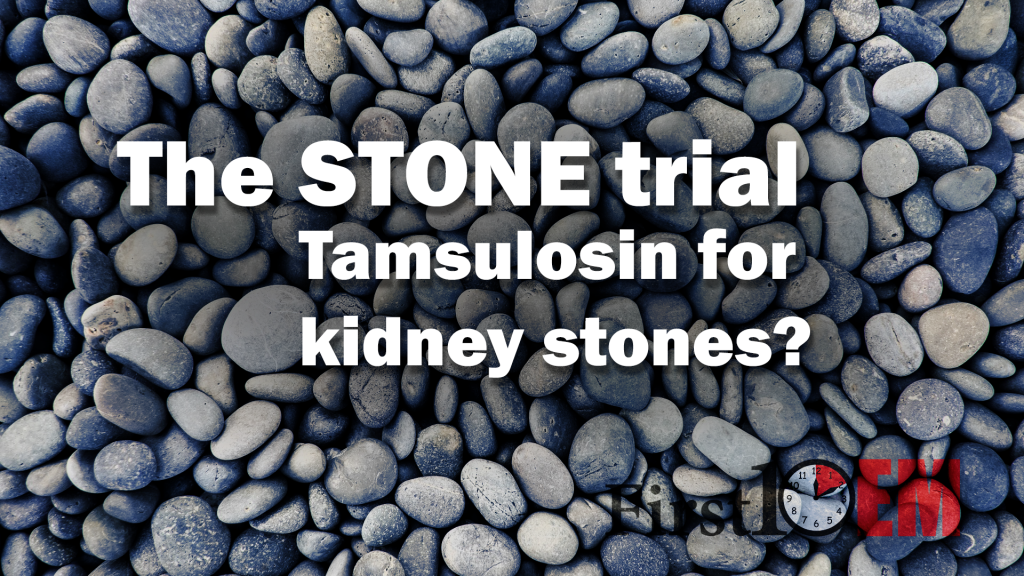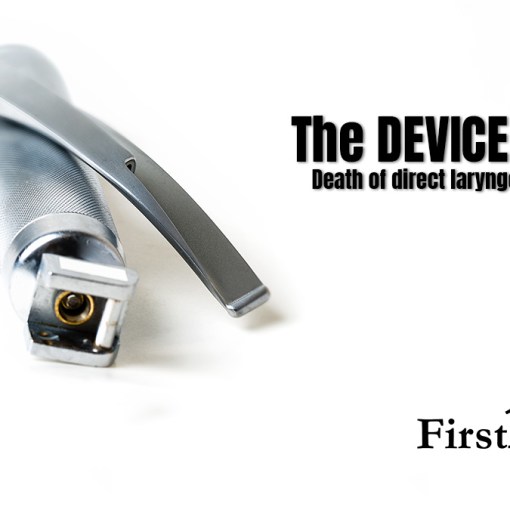This again? I know I’ve covered tamsulosin for kidney stones a number of times before. I image most people can predict the results of this study. It may seem a bit repetitive, but I think there is an important EBM lesson in this data.
The paper
Meltzer AC, Burrows PK, Wolfson AB, et al. Effect of Tamsulosin on Passage of Symptomatic Ureteral Stones: A Randomized Clinical Trial. JAMA internal medicine. 2018. PMID: 29913020
The Methods
This is a multicenter, double-blind, placebo-controlled RCT.
Patients: Adult patients (18 years and older) with symptomatic nephrolithiasis (less than 10mm) confirmed on CT scan.
Intervention: Tamsulosin 0.4mg by mouth daily.
Comparison: Placebo.
Outcome: Primary outcome was passage of stone at 28 days by patient’s visualization or physical capture.
- Secondary outcomes included stone passage on a second CT, discontinuation of medicine, surgical procedures, hospitalization, return ED visits, and duration of pain.
The trial was registered on clinicaltrials.gov, but the outcomes weren’t submitted until after the trial data was already collected, making the submission somewhat meaningless.
The Results
They included 512 patients. (27% female; mean age 40)
There was no difference in the primary outcome of clinical stone passage at 28 days (49.6% vs 47.3%, RR 1.05, 95% CI 0.87-1.27, p=0.6).
There was also no difference in passage in the subset of patients who had a confirmatory CT scan (84% vs 78%).
None of the secondary outcomes were different between the two groups.
The size of the stone did not matter. In fact, in the larger stones (the subgroup in which previous studies hinted at a benefit) the point estimate for passage rate was higher with placebo (34% vs 31%).
Side effects were similar, except significantly more patients on tamsulosin had abnormalities of ejaculation (18% vs 7%).
My thoughts
The results of this trial are not surprising. We have a number of high quality studies on this topic demonstrating the same thing: tamsulosin doesn’t work. (Ferre 2009, Picard 2015, Berger 2015, Furyk 2016) Perhaps the only surprising thing here is just how many RCTs we can get done on a rather inconsequential topic, when 20 years can go by without a proper validation of NINDS.
So the real question here is: why should you care? This is a pretty boring, low-yield topic, but for some reason the EBM nerds of the world won’t shut up about tamsulosin. Personally, I think this topic is important because it demonstrates a classic pattern in research that we all must understand. Early studies in most topics tend to be small and methodologically poor. Those studies, or at least the subset that we see published, often show impressive results, and the medical community will quickly adopt the new therapy despite the significant research limitations. Ultimately, one or more large studies with excellent methods will demonstrate no benefit, but we struggle to adjust to the much more robust evidence.
There are a number of reasons why this phenomenon exists. Regression to the mean can explain some results, where interesting outliers are published early and future studies are likely to be less extreme. A major contributor is publication bias. It is relatively easy to run small, poor quality trials, and so less painful to leave negative (or ‘boring’) studies unpublished, skewing the available literature towards the appearance of benefit. Finally, the earlier, smaller trials often have significant methodological problems that can explain their positive results.
It is worth reading some of the early trials of tamsulosin for kidney stones to get a sense of the critical importance of basic research principles like blinding. The vast majority of the early (positive) trials of medical expulsive therapy were unblinded. When seeing a patient in their office after 1 week, the urologist would know whether or not the patient was on tamsulosin. Because tamsulosin was thought (or “known”) to help, they might decide to give the patient in the tamsulosin an extra week to pass their stone, while bringing the control patient directly to the operating room. (Cervenàko 2002. Dellabella 2003, Hollingsworth 2013)
This pattern also explains why, despite being higher on the classic EBM pyramid, meta-analyses are often less helpful than high quality RCTs. Adding multiple small, methodologically flawed papers together does not magically give you a more accurate result. Combining multiple papers together, and thereby increasing the total number of participants studied, can help increase the statistical precision of our estimate, but that doesn’t help us if the accuracy was poor.
It is also probably worth taking a moment to comment on secondary outcomes. In two prior trials, much has been said about the fact that in secondary, subgroup analyses tamsulosin looked like it might work with large (>5mm) distal stones. (Pickard 2015, Furyk 2016) In this study, the point estimates were actually reversed, with tamsulosin looking worse than placebo in larger stones. (However, there were a lot fewer large stones in this study than in the previous studies). The point is that secondary outcomes and subgroup analysis are very difficult to interpret. When many outcomes are studied, some are destined to be statistically significant by chance alone. Studies are supposed to adjust their statistics for the number of outcomes measured, but frequently do not. Furthermore, even within a study, outcomes might be subject to publication bias, as authors can perform many different subgroup analyses and only publish the interesting (aka positive) results they find. In general, secondary outcomes should be seen as hypothesis generating for future research, but shouldn’t be the primary driver of clinical practice.
Finally, these studies are difficult to implement from a clinical stand point. They only include patients with stones confirmed on CT. Most patients with nephrolithiasis don’t need a CT. In fact, most probably don’t need any imaging at all, at least initially, as long as your are comfortable that you are not missing an alternative, dangerous diagnosis. We definitely don’t want to be increasing our radiation to patients just to determine who to provide with the seemingly ineffective tamsulosin prescription.
Bottom line
All therapies come with harms and costs. When there is no benefit, which seems to be the case with tamsulosin for nephrolithiasis, a therapy should be avoided.
Other FOAMed
REBEL EM: Can tamsulosin get that STONE to drop?
References
Berger DA, Ross MA, Hollander JB, et al. Tamsulosin does not increase 1-week passage rate of ureteral stones in ED patients. The American journal of emergency medicine. 2015; 33(12):1721-4. PMID: 26429522
Cervenàkov I, Fillo J, Mardiak J, Kopecný M, Smirala J, Lepies P. Speedy elimination of ureterolithiasis in lower part of ureters with the alpha 1-blocker–Tamsulosin. International urology and nephrology. 2002; 34(1):25-9. PMID: 12549635
Dellabella M, Milanese G, Muzzonigro G. Efficacy of tamsulosin in the medical management of juxtavesical ureteral stones. The Journal of urology. 2003; 170(6 Pt 1):2202-5. PMID: 14634379
Ferre RM et al. Tamsulosin for Ureteral Stones in the ED: a Randomized, Controlled Trial. Ann of EM 2009; 54: 432-9. PMID: 19200622
Hollingsworth JM et al. Alpha blockers for treatment of ureteric stones: systematic review and meta-analysis. BMJ 2016. PMID: 27908918
Furyk JS et al. Distal ureteric stones and tamsulosin: a double-blind, placebo-controlled, randomized, multicenter trial. Ann Emerg Med 2016; 67(1): 86-95. PMID: 26194935
Pickard R et al. Medical expulsive therapy in adults with ureteric colic: a multicentre, randomised, placebo-controlled trial. Lancet 2015; 386(9991): 341-9. PMID: 25998582
Morgenstern, J. Tamsulosin for kidney stones: The STONE trial, First10EM, July 9, 2018. Available at:
https://doi.org/10.51684/FIRS.6058






3 thoughts on “Tamsulosin for kidney stones: The STONE trial”